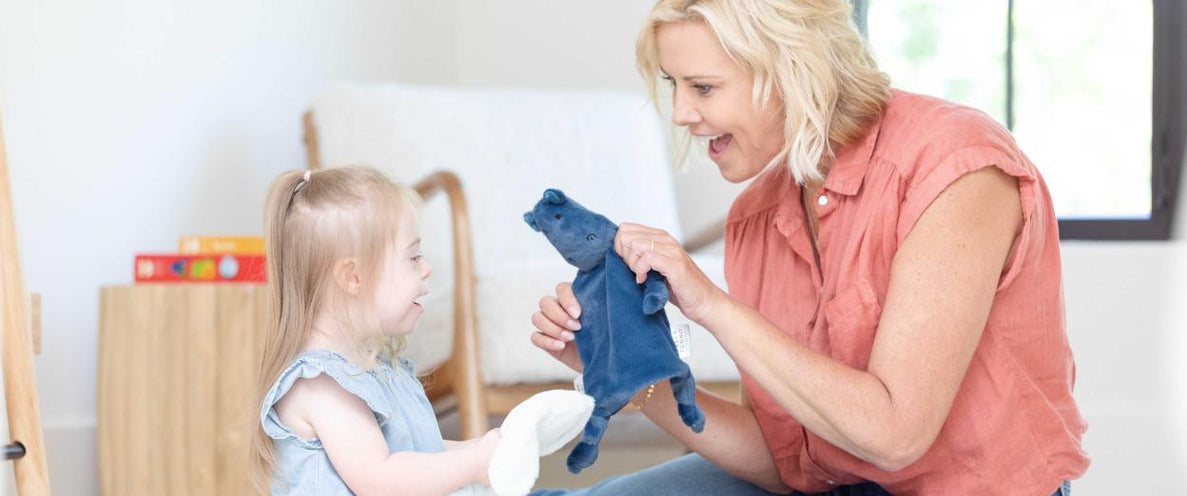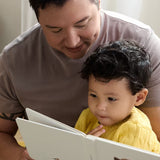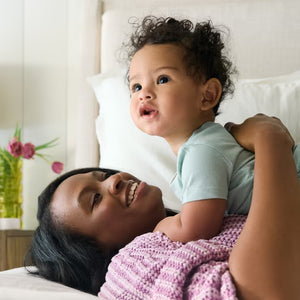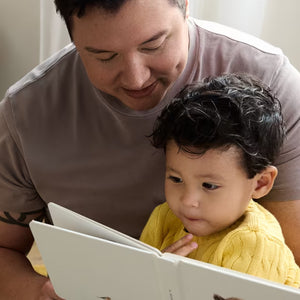Do you remember a special stuffed animal or blanket from when you were young? Many little ones bond with a lovey, blankie, or other comfort object during their early years. Let’s talk about how a lovey or security blanket can help your little one (12 months and older) with sleep!
What is a lovey?
A lovey is an object, like a stuffed animal or blanket, that your baby or toddler forms a special attachment to and uses for comfort. You may also hear these called: transitional objects, comfort objects, or security blankets. A lovey provides a feeling of security to your little one and can provide comfort for transitions, new experiences, and unfamiliar environments. Once your little one is 12 months or older, they can also be helpful for sleep.
Safety Tip: Please remember, we don’t want anything (other than a fitted sheet and a pacifier) in the crib until your baby is 12 months or older.
What are the benefits of a lovey?
Did you know that a lovey is more than just a cute toy? There are HUGE benefits to introducing a lovey or security blanket.
-
Research shows that hugging something, even an inanimate object like a soft lovey or teddy bear, releases oxytocin, a hormone that makes us feel calmed and soothed.
-
By incorporating a lovey in your bedtime routine, the lovey will actually help cue your toddler’s brain that it’s time for sleep.
-
As little ones become more independent and mobile, they may experience separation anxiety and they often need more reassurance that they’re safe and secure. The positive attachment they have with a lovey can provide confidence to explore their world more freely.
-
A lovey or security blanket can help with bedtime fears and nightmares as your toddler’s imagination grows. When you snuggle with the lovey together, your toddler associates the lovey with the loving security they feel when you’re nearby.
-
The American Academy of Pediatrics (AAP) supports the use of a lovey as a tool for emotional support. According to the AAP, "Despite myths to the contrary, transitional objects are not a sign of weakness or insecurity, and there's no reason to keep your child from using one. In fact, a transitional object can be so helpful you may want to help them choose one and build it into their nighttime ritual."
-
A bond with a lovey or transitional object can provide reassurance during transitions (like adding a sibling or changing rooms at daycare), teething, or illness.
Safety Tip: Loveys or comfort objects can only be used for sleep when a little one is older than 12 months.
When can babies sleep with a lovey? When can babies sleep with a stuffed animal?
After your baby turns 12 months old, the American Academy of Pediatrics says it’s safe for them to sleep with a lovey or blanket. Before your baby’s first birthday, the AAP recommends the sleep environment be free of loose bedding, blankets, stuffed animals, comfort objects, and pillows.
Expert Tip: While some little ones do use a blankie as a security item or lovey, I still recommend a sleep sack for warmth until your little one is out of the crib.
Please check with your pediatrician if you have any concerns about introducing a lovey or security blanket.
Need more safe sleep tips? Check out my Safe Sleep Checklist.
When should I introduce a lovey?
Loveys can be used for sleep any time after your child's first birthday. However, you can introduce a lovey to use outside of the crib at any age. Yes, even prior to 12 months. Loveys can be beneficial even when your baby isn't old enough to safely use it for sleep time.
How can you use a lovey before 12 months?
- Rub it over your little one’s cheeks during feeding sessions.
- Snuggle with it as you read books.
- Tuck it between the two of you when you cuddle.
- Take it with you on walks in the stroller.
- Offer it when your baby is upset.
Then, after their first birthday, they can have it in the crib with them.
A bond with a lovey or transitional object can provide reassurance during separation anxiety, new experiences (like traveling on a plane, visiting family, or starting daycare), and times of discomfort (like teething, reflux pain, or illness). On the flip side, if your toddler is 2 or 3 and hasn't attached to a lovey, it's not too late to introduce one.
If you have any concerns about introducing a comfort object, please talk to your pediatrician.
Expert Tip: If you attempt to introduce a lovey and your child doesn’t immediately take to it, don’t give up! Some babies may show an interest in their lovey months before their first birthday, while others may not show an interest until they’re older. Keep incorporating the tips below, and know that whether your child chooses to bond with a lovey is up to them.
What is the best lovey for a baby?
Look for a lovey that is:
-
Soft: You’ll want it to be comfortable for your little one in case they roll on it during sleep.
-
Free of loose parts and choking hazards: No button eyes or removable parts.
-
An appropriate size: Think big enough to snuggle, but small enough to pick up and hold on their own.
-
Easy to duplicate or replace: Consider purchasing a duplicate (or several) that you can rotate.
Let me tell you about my favorite lovey. It’s a lovey that I designed with Bella Tunno and is the true Taking Cara Babies favorite. Before I tell you about them, you have to see them:
These loveys are soft, the perfect size to fit in your little one’s hand (but also great to snuggle), come in 8 different styles, and have little tags on the side. When my son was little, he loved rubbing those little tags on his lovey, and I know your little one will too.
There is one extra special thing about our partnership with Bella Tunno. Not only did we create the perfect lovey, but with each purchase we’re donating two meals to hungry kids. When you buy a lovey, you will be bringing a little extra good into the world.
If your baby or toddler has developed an attachment to a comfort object already, there’s no need to make a switch (as long as it’s safe)! And remember, a lovey or comfort object should only go in the crib when a baby is 12 months or older.
Expert Tip: Be sure to have at least two of the same loveys and rotate your lovey often. Leaving your child’s lovey at a restaurant, losing it on family vacation, or even realizing it’s still in the washing machine at bedtime can be stressful for you and your child. Rotating between them each week can help them all have the same amount of wear. We want all of the loveys to be loved, cuddled, and even washed equally so that they feel and smell the same to your child.
(Bonus: Bella Tunno sells 3-packs so that you always have a spare around.)
How can I introduce a lovey?
If you’d like to introduce a lovey to your baby before they turn one year old, just remember that it should only be given to them outside of the crib while they’re awake. After 12 months, a lovey or security blanket can join your baby for sleep in the crib.
1. Prepare to introduce the lovey.
Choose your lovey carefully thinking about safety and that this lovey will likely become a part of your child’s life for years to come. Consider sleeping with the lovey yourself or tucking it into your shirt for a bit so that it smells familiar when you introduce it to your child.
2. Include the lovey in your everyday life.
Incorporate the lovey in your nursing or bottle feeding sessions; you can rub it on your baby's cheeks or along their fingers. Include the lovey in playtime- like serving the lovey some tea at a tea party. Involve the lovey or security blanket in snuggles with you and your little one. Tuck the lovey next to your child in the stroller as you walk to the park.
3. Make the lovey part of your nap and bedtime routines.
Encourage your little one to hold the lovey during snuggles and bedtime books. If your lovey is a stuffed animal, kiss it goodnight and give your toddler a chance to do the same.
Cover their lovey in kisses and remind them that if they’re missing you in the night, all they need to do is rub their lovey or blankie on their cheek and all your kisses are there! This is helpful for bonding with a lovey and combating separation anxiety. (Remember, the lovey can only go into the crib with your little one if they're 12 months or older.)
4. Be patient.
Your little one may not seem interested in a lovey at first. Developing an emotional connection to a baby lovey or comfort object can take time. Keep offering opportunities to interact or snuggle with the lovey, and just know that whether your child chooses to bond with a lovey is up to them.
Please know, a lovey is certainly not a requirement to have a good sleeper. If your baby or toddler is struggling with sleep, my classes can help! I’ll teach you a holistic and customizable step-by-step plan to help your little one get the sleep they need and for your family to thrive whether you have a baby (between 5 and 24 months) or a toddler (between 2 and 4 years).







